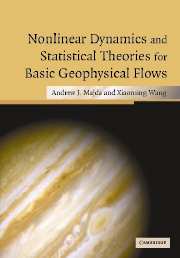Book contents
- Frontmatter
- Contents
- Preface
- 1 Barotropic geophysical flows and two-dimensional fluid flows: elementary introduction
- 2 The response to large-scale forcing
- 3 The selective decay principle for basic geophysical flows
- 4 Non-linear stability of steady geophysical flows
- 5 Topographic mean flow interaction, non-linear instability, and chaotic dynamics
- 6 Introduction to information theory and empirical statistical theory
- 7 Equilibrium statistical mechanics for systems of ordinary differential equations
- 8 Statistical mechanics for the truncated quasi-geostrophic equations
- 9 Empirical statistical theories for most probable states
- 10 Assessing the potential applicability of equilibrium statistical theories for geophysical flows: an overview
- 11 Predictions and comparison of equilibrium statistical theories
- 12 Equilibrium statistical theories and dynamical modeling of flows with forcing and dissipation
- 13 Predicting the jets and spots on Jupiter by equilibrium statistical mechanics
- 14 The statistical relevance of additional conserved quantities for truncated geophysical flows
- 15 A mathematical framework for quantifying predictability utilizing relative entropy
- 16 Barotropic quasi-geostrophic equations on the sphere
- Index
11 - Predictions and comparison of equilibrium statistical theories
Published online by Cambridge University Press: 30 November 2009
- Frontmatter
- Contents
- Preface
- 1 Barotropic geophysical flows and two-dimensional fluid flows: elementary introduction
- 2 The response to large-scale forcing
- 3 The selective decay principle for basic geophysical flows
- 4 Non-linear stability of steady geophysical flows
- 5 Topographic mean flow interaction, non-linear instability, and chaotic dynamics
- 6 Introduction to information theory and empirical statistical theory
- 7 Equilibrium statistical mechanics for systems of ordinary differential equations
- 8 Statistical mechanics for the truncated quasi-geostrophic equations
- 9 Empirical statistical theories for most probable states
- 10 Assessing the potential applicability of equilibrium statistical theories for geophysical flows: an overview
- 11 Predictions and comparison of equilibrium statistical theories
- 12 Equilibrium statistical theories and dynamical modeling of flows with forcing and dissipation
- 13 Predicting the jets and spots on Jupiter by equilibrium statistical mechanics
- 14 The statistical relevance of additional conserved quantities for truncated geophysical flows
- 15 A mathematical framework for quantifying predictability utilizing relative entropy
- 16 Barotropic quasi-geostrophic equations on the sphere
- Index
Summary
Introduction
In the previous Chapters 6, 8, and 9, various statistical theories have been introduced to predict large-scale structures for geophysical flows. These statistical theories range from the simple energy–enstrophy theory (EEST) developed in Chapters 6 and 8, point vortex theory (PVST) from Section 9.3, empirical statistical theory with a prior distribution and a few external constraints (ESTP) introduced in Chapter 9 and recalled in Chapter 10, to the elaborate equilibrium statistical theory involving many constraints (ESTMC) developed in Section 9.4. In the presence of such a wide variety of theories, a central question is the applicability of these statistical theories to geophysical flows. As indicated in Chapter 10, the purpose of this chapter is to address several practical as well as theoretical issues pertinent to the potential applicability of various equilibrium statistical theories. In particular we will address three applied issues, (A-1)–(A-3), and two theoretical issues, (T-1)–(T-2) of Chapter 10. We will provide strong evidence, both numerical and analytical, in supporting the central role of equilibrium statistical theories with judicious prior distribution and few external constraints.
- Type
- Chapter
- Information
- Publisher: Cambridge University PressPrint publication year: 2006



